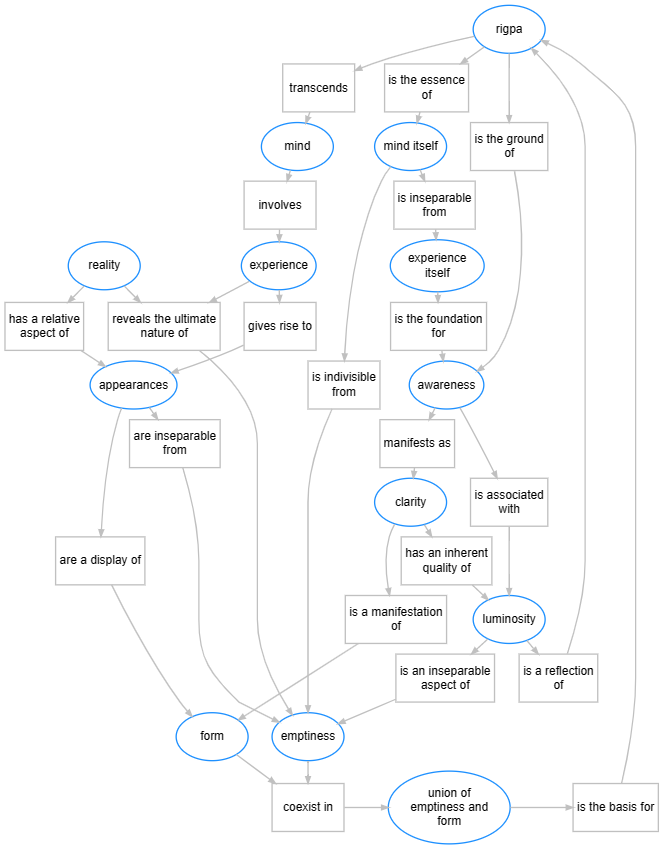Dzogchen, also known as the Great Perfection, is a profound and advanced spiritual practice within Tibetan Buddhism that aims to help individuals recognize and maintain the natural state of mind, known as rigpa. This natural state is said to be inherently pure, free from duality, and the source of all experiences. In this article, we will delve into the interconnected concepts of Dzogchen as illustrated in the accompanying graph and discuss the importance of the union of emptiness and form, which is central to Dzogchen teachings. We will begin by discussing rigpa and then explore the various relationships between the concepts in the graph, ultimately culminating in a discussion of the union of emptiness and form.

Rigpa: The Foundation
At the heart of Dzogchen is the recognition of rigpa, the innate and primordial awareness that transcends the ordinary dualistic mind. Rigpa is the ground of all experiences and the essence of mind itself. From rigpa, the dualistic mind emerges, which in turn gives rise to various experiences. Rigpa is also the ground of awareness, which is the knowing aspect of consciousness.
Mind, Experience, and their Intrinsic Connection
In the context of Dzogchen, the nature of the mind and its connection to experiences play a vital role in understanding the ultimate nature of reality. According to graph, the mind is intrinsically linked to rigpa, the innate, primordial awareness that transcends ordinary dualistic consciousness. Rigpa is considered the essence of the mind itself, and it is this essence that forms the basis for our experiences.
The mind, as we generally understand it, is the aspect of our consciousness that gives rise to thoughts, emotions, and perceptions. It is through the mind that we engage with our experiences in the relative world. The mind itself is indivisible from emptiness, indicating that the ultimate nature of the mind is empty of inherent existence. Consequently, the mind itself is inseparable from rigpa, and therefore, our experiences are also rooted in this primordial awareness.
The graph further illustrates the relationship between mind, mind itself, experience, and experience itself. While the mind is involved in our everyday experiences, the mind itself is inseparable from the ultimate nature of experience, which is experience itself. Experience itself is the direct, non-dual awareness of the true nature of phenomena. This recognition highlights the interconnectedness and interdependence between the mind and experiences, both in their relative and ultimate aspects.
The Nature of Appearances and Reality
Appearances, in the context of Dzogchen, refer to the diverse array of phenomena that manifest in our everyday experience. They encompass everything we see, hear, taste, touch, and think. Appearances are considered inseparable from emptiness, the ultimate nature of reality, which is devoid of inherent existence. As the graph indicates, appearances are a display of form, arising from the relative aspect of reality.
In Dzogchen, it is taught that appearances and emptiness are inseparable. This inseparability means that appearances are not separate entities from their ultimate nature, emptiness. They are, in fact, interconnected and interdependent. The reason behind this inseparability lies in the understanding that all phenomena, including appearances, are devoid of inherent existence. They arise due to causes and conditions and are subject to change and dissolution.
Emptiness, Form, and their Union
Emptiness is not a void or nothingness; rather, it is the potential for appearances to manifest. It signifies the lack of inherent existence in all phenomena, and yet it allows for the interdependence and interconnectedness of all things. Appearances, in turn, reveal the illusory nature of reality. While they seem solid and independent at first glance, upon closer examination, they reveal themselves as being empty of inherent existence, thus highlighting the union of emptiness and form.
Emptiness thus represents the ungraspable, interdependent, and empty nature of all phenomena. Form, on the other hand, refers to the myriad appearances and experiences that arise within our consciousness. The graph demonstrates that form is a manifestation of clarity and coexists with emptiness in the union of emptiness and form. This union is the basis for rigpa and is a crucial concept in understanding the nature of reality in Dzogchen.
Clarity, Luminosity, and their Interdependence
As illustrated in the graph, clarity is a manifestation of form and has an inherent quality of luminosity. In Dzogchen, clarity represents the clear and vivid nature of conscious experience, while luminosity refers to the innate capacity of awareness to illuminate and make experiences known. These two aspects are inseparable, as clarity and luminosity together reveal the nature of mind and experience.
Awareness, Emptiness, and Form: The Indivisible Trio
Awareness, or the knowing aspect of consciousness, manifests as clarity and is associated with luminosity. In the context of Dzogchen, awareness is the ground of both emptiness and form, reflecting their indivisible nature. The union of emptiness and form signifies the non-dual nature of reality, where the ultimate nature of phenomena (emptiness) and their appearances (form) are inseparable aspects of a single, indivisible whole.
The recognition of the union of emptiness and form allows one to transcend the dualistic mind, leading to a realization of the true nature of reality and bringing about profound spiritual transformation. In this way, the teachings of Dzogchen, as illustrated by the relationships depicted in the graph, guide practitioners on a journey to realize the ultimate truth and attain lasting inner peace.
Clarity shines bright,
Luminous awareness dawns,
Emptiness takes form.